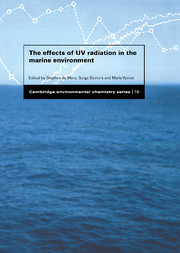Book contents
- Frontmatter
- Contents
- Contributors
- Preface
- 1 Enhanced UV radiation – a new problem for the marine environment
- 2 UV physics and optics
- 3 Spectral weighting functions for quantifying effects of UV radiation in marine ecosystems
- 4 Marine photochemistry and its impact on carbon cycling
- 5 Photochemical production of biological substrates
- 6 Mechanisms of UV damage to aquatic organisms
- 7 Strategies for the minimisation of UV-induced damage
- 8 UV radiation effects on heterotrophic bacterioplankton and viruses in marine ecosystems
- 9 Effects of UV radiation on the physiology and ecology of marine phytoplankton
- 10 Impact of solar UV radiation on zooplankton and fish
- 11 Implications of UV radiation for the food web structure and consequences on the carbon flow
- Index
Preface
Published online by Cambridge University Press: 20 August 2009
- Frontmatter
- Contents
- Contributors
- Preface
- 1 Enhanced UV radiation – a new problem for the marine environment
- 2 UV physics and optics
- 3 Spectral weighting functions for quantifying effects of UV radiation in marine ecosystems
- 4 Marine photochemistry and its impact on carbon cycling
- 5 Photochemical production of biological substrates
- 6 Mechanisms of UV damage to aquatic organisms
- 7 Strategies for the minimisation of UV-induced damage
- 8 UV radiation effects on heterotrophic bacterioplankton and viruses in marine ecosystems
- 9 Effects of UV radiation on the physiology and ecology of marine phytoplankton
- 10 Impact of solar UV radiation on zooplankton and fish
- 11 Implications of UV radiation for the food web structure and consequences on the carbon flow
- Index
Summary
Insofar as UV radiation (UVR) is a natural component of solar radiation, the marine environment has always been exposed to UVR. However, anthropogenic influences via stratospheric ozone depletion have caused an increase in the UVR flux to the earth's surface in recent years. In this way, the effects of enhanced UVR on the marine environment can be considered to be a new problem. Moreover, the relative change in the UVR flux is greatest in the polar regions, which are most susceptible to ‘ozone hole’ formation in the spring, arguably a very sensitive time for marine organisms. Recognition of the Antarctic ozone hole initially prompted considerable research aimed at phytoplankton, owing to their importance in primary production. Subsequent investigations were extended to consider both the microbial loop and higher trophic levels. Elucidating responses at the ecosystem level remains the ongoing challenge in this field.
This book is aimed at researchers and the postgraduate student market, providing a state of the art review of UVR effects in the marine environment. A multidisciplinary approach is adopted such that basic properties of the relevant physics, chemistry and biology are included. The fate and effects of UVR are treated as a continuum, with the underlying intent to try to follow the pathway and fate of a UV photon. The progression considers firstly optical properties and the attenuation of UVR in the atmosphere and seawater. Then the wavelength dependence of absorption by both molecules and organisms is explained.
- Type
- Chapter
- Information
- Publisher: Cambridge University PressPrint publication year: 2000
- 1
- Cited by

